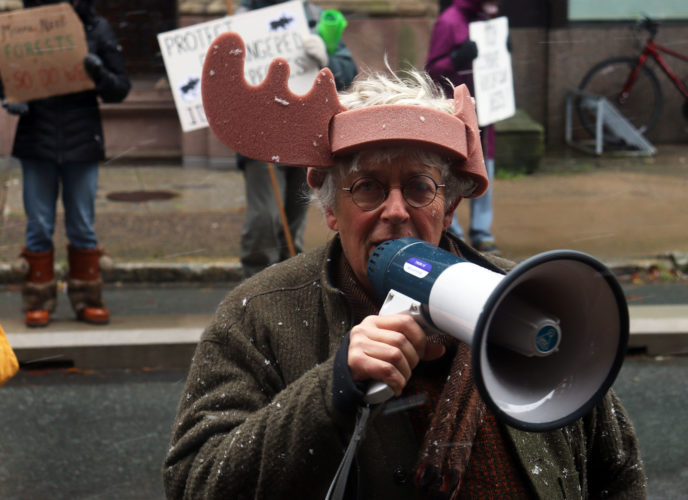Logging threatens mainland moose, say opponents
Province releases new recovery plan for endangered population

caption
Dozens of protesters in downtown Halifax demanded a halt to logging at Rocky Point Lake on Wednesday.An important habitat for the already endangered mainland moose is being chopped down, say opponents of a logging operation in southwest Nova Scotia.
“It’s clear to me that the government’s written off the mainland moose just by the way they’re letting the forest companies manage,” Bob Bancroft, Nova Scotia Nature president, said on Thursday about logging in an area around Rocky Point Lake.
Between 2,500 and 4,000 moose roamed mainland Nova Scotia in the 1960s, according to the mainland moose recovery plan released on Thursday. The species was declared endangered in 2003. It’s unclear how many mainland moose remain, but the province will conduct a new survey this winter.
Bancroft, a retired wildlife biologist, used to record moose sightings, droppings and tracks for the province. He estimates there’s around 100 moose on the province’s mainland, but nobody knows for sure. A 2019 CBC investigation that included an aerial survey estimated there could be fewer than 100 mainland moose in the wild. Related stories
Netukulimk: Our way forward
Bancroft says the steep decline in the province’s mainland moose population can be attributed to human encroachment. He said about half of Nova Scotia’s forests have been cut over the past 35 years.
“Moose need forests,” Bancroft said. “They need to escape heat in the summer in mature forests, then they need to escape the cold in softwood forests during the winter. But they need to eat to in patches of younger forest nearby.”
Bob Petrie, director of wildlife with the Department of Natural Resources, says the recovery plan identifies core habitat for the moose. The recommendation will help the department manage the landscape to help the mainland moose recover. About two-thirds of core habitat is located on Crown land or protected areas.
The Rocky Point Lake area, which is about 50 km south of Digby, appears to be within the designated core habitat in maps that accompany release of the plan. But there is no mention of whether logging can continue.

caption
Demonstrators donned moose costumes as part of their protest in Halifax on Wednesday.The logging Bancroft was describing was the subject of a blockade last year, as nine protesters were arrested for camping out and blocking access to a parcel of land around Rocky Point Lake.
On Wednesday, that conflict moved from those remote forests in southwest Nova Scotia to the office of the Department of Natural Resources and Renewables in Halifax.
Dozens of protesters, led by Extinction Rebellion Mi’kma’ki/Nova Scotia, demanded an immediate halt to WestFor Management’s logging operations around Rocky Point Lake.
Nina Newington was one of the protesters arrested last year near the site. She was one of the co-ordinators of the Halifax demonstration.
“Our message to the government is to stop clearcutting of Rocky Point right now,” she said. “Southwest Nova Scotia has the biggest moose concentration on the province’s mainland. It’s also the last place on the mainland that hasn’t been completely ravaged.”

caption
Nina Newington addresses the crowd at the protest on Wednesday.Clifford Paul said the logging operation around Rocky Point Lake goes against Netukulimk and Mi’kmaq treaty rights. He is the Unama’ki Institute of Natural Resources moose management co-ordinator.
Netukulimk is a Mi’kmaw way of sustainable resource management. It prioritizes achieving adequate community nutrition and economic well-being without jeopardizing the integrity, diversity or productivity of the environment.
“Proposing a clearcut to areas where the moose can make a comeback is counterproductive to Netukulimk,” Paul said. “It’s counterproductive to the perpetuity of not only the ecosystem for moose, but the moose population themselves. How can a species such as the mainland moose survive if we keep chipping away what’s good for them?”

caption
Protesters play dead outside the Department of Natural Resources and Renewables office on Hollis Street on Wednesday.In October 2020, the Assembly of Nova Scotia Mi’kmaq Chiefs called for a halt of logging operations until a mainland moose assessment could be done.
WestFor management resumed logging operations last month.
WestFor said in a news release Wednesday their logging operation at Rocky Point Lake was not a clearcut. They say 60 per cent of trees remain standing.
“Proper forest management creates habitat necessary for mainland moose and that’s what we are doing at Rocky Point Lake,” said WestFor general manager Breck Stuart.
Bancroft disagrees.
“I saw some of the cutting when I was there a couple of weeks ago and the cutting over the whole area is clearcutting,” he said. “It’s not moose management; it’s fibre extraction from public lands for private profit.”
About the author

Will McLernon
Will McLernon is a journalist with The Signal. He is currently finishing up his Bachelor of Journalism (Honours) degree with a minor in International...

J
John Fraser